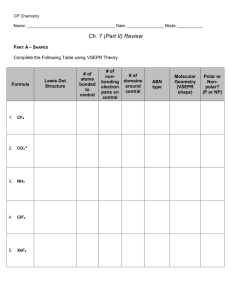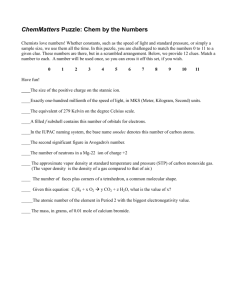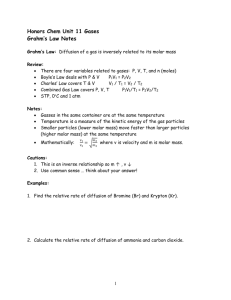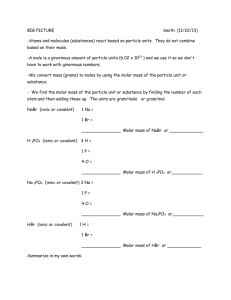Harris QCA 8e Chapter 07
advertisement
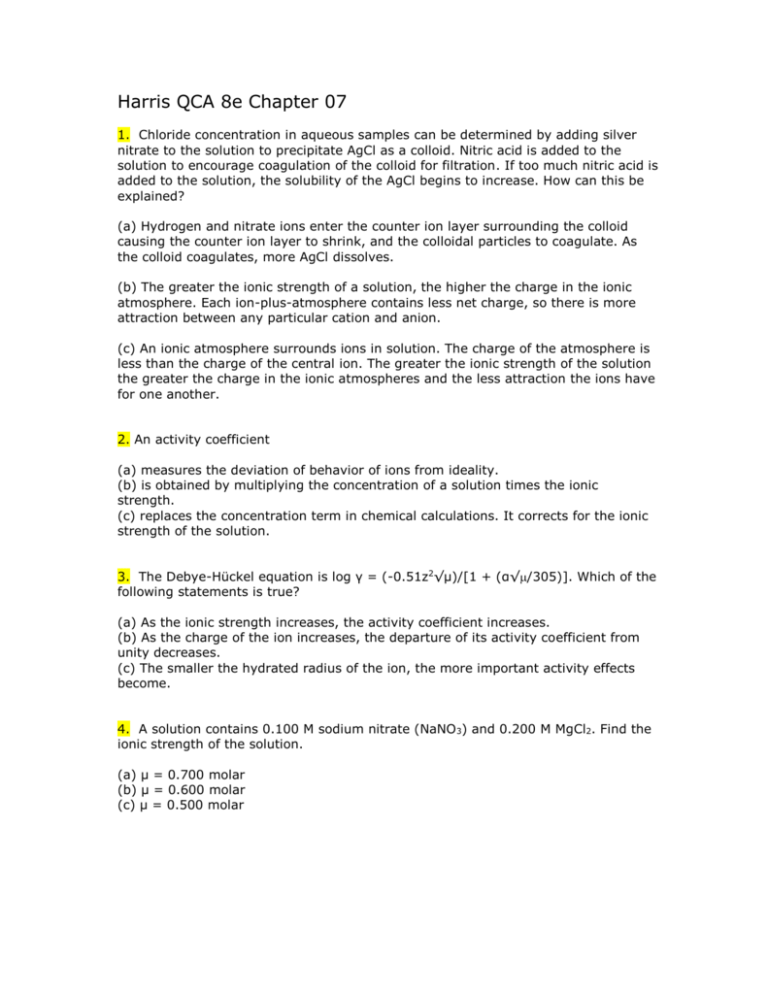
Harris QCA 8e Chapter 07 1. Chloride concentration in aqueous samples can be determined by adding silver nitrate to the solution to precipitate AgCl as a colloid. Nitric acid is added to the solution to encourage coagulation of the colloid for filtration. If too much nitric acid is added to the solution, the solubility of the AgCl begins to increase. How can this be explained? (a) Hydrogen and nitrate ions enter the counter ion layer surrounding the colloid causing the counter ion layer to shrink, and the colloidal particles to coagulate. As the colloid coagulates, more AgCl dissolves. (b) The greater the ionic strength of a solution, the higher the charge in the ionic atmosphere. Each ion-plus-atmosphere contains less net charge, so there is more attraction between any particular cation and anion. (c) An ionic atmosphere surrounds ions in solution. The charge of the atmosphere is less than the charge of the central ion. The greater the ionic strength of the solution the greater the charge in the ionic atmospheres and the less attraction the ions have for one another. 2. An activity coefficient (a) measures the deviation of behavior of ions from ideality. (b) is obtained by multiplying the concentration of a solution times the ionic strength. (c) replaces the concentration term in chemical calculations. It corrects for the ionic strength of the solution. 3. The Debye-Hückel equation is log γ = (-0.51z2√μ)/[1 + (α√/305)]. Which of the following statements is true? (a) As the ionic strength increases, the activity coefficient increases. (b) As the charge of the ion increases, the departure of its activity coefficient from unity decreases. (c) The smaller the hydrated radius of the ion, the more important activity effects become. 4. A solution contains 0.100 M sodium nitrate (NaNO 3) and 0.200 M MgCl2. Find the ionic strength of the solution. (a) μ = 0.700 molar (b) μ = 0.600 molar (c) μ = 0.500 molar 5. Using Equation 7-7 and Table 7-1 in your text, calculate the activity coefficient for Ca in a 0.01 M solution of Ca(ClO4)2? (a) 0.580 (b) 0.675 (c) 0.485 6. Calculate the solubility of silver bromate (AgBrO3), using activities, in a saturated solution of silver bromate. Ksp for Ag(BrO3) = 5.5 x 10-5. (a) 7.4 x 10-3 molar (b) 8.1 x 10-3 molar (c) 7.8 x 10-3 molar 7. What is the pH of water containing 0.0333 M Ca(NO3)2. (a) 7.00 (b) 6.98 (c) 7.02 8. At very low concentrations the activity coefficients approach 1. Ignoring activity coefficients, calculate the solubility of Co(OH)3 in a saturated solution of Co(OH) 3. Ksp for cobalt(III) hydroxide = 3 x 10-45. (a) 3 x 10-12 molar (b) 3 x 10-38molar (c) 3 x 10-24 molar 9. A pH 8.0 solution of magnesium carbonate is saturated with MgCO3. What is the [Mg2+]? Ksp for MgCO3 = 3.5 x 10-8 and for H2CO3 K1 = 4.6 x 10-7 and K2 = 4.4 x 10-11. (a) 2.9 x 10-3 molar (b) 1.9 x 10-4 molar (c) 7.7 x 10-6 molar 10. Given the chemical equilibrium HC2H3O2 + H2O= C2H3O2- + H3O+, which of the following best represents the mathematical expression of this equilibrium. (a) [H3O+][C2H3O2-]/HC2H3O2 = Ka (b) [H3O+]H3O+ [C2H3O2-]C2H3O2-/HC2H3O2 HC2H3O2 = Ka (c) [H3O+][C2H3O2-]/HC2H3O2 = Ka γa 11. Magnesium carbonate is slightly soluble in water. The Ksp for MgCO3 is 3.5 X 10-8. The carbonate ion being a conjugate base may form the bicarbonate ion (HCO3-) and carbonic acid (H2CO3) in solution. Which of the following represents the correct mass balance equation at a pH of 7.5 for this system? (a) 2[Mg2+] = 2[CO32-] + [HCO3-] + [H2CO3] (b) [Mg2+] = [CO32-] + [HCO3-] + [H2CO3] (c) [Mg2+] = [CO32-] + [HCO3-] 12. Silver arsenate (Ag3AsO4) is only slightly soluble in water. The compound arsenic acid (H3AsO4) behaves in much the same manner as phosphoric acid. Which of the following represent a mass balance equation for the solution at pH 8.0? (a) [Ag+]/3 = [AsO43-] + [HAsO42-] + [H2AsO4-] + [H3AsO4] (b) [Ag+] = [AsO43-] + [HAsO42-] + [H2AsO4-] + [H3AsO4] (c) [Ag+] + [H+] = 3[AsO43-] + 2[HAsO42-] + [H2AsO4-] + [H3AsO4] + [OH-] 13. A solution contains a 0.100 M Al(NO3)3 and 0.100 M MgCl2. Which of the following represents the correct charge balance equation for this system? (a) 3[Al3+] + 2[Mg2+] = [NO3-] + [Cl-] (b) [Al3+] + [Mg2+] + [H+] = 3[NO3-] + 2[Cl-] + [OH-] (c) 3[Al3+] + 2[Mg2+] + [H+] = [NO3-] + [Cl-] + [OH-] 14. Which of the following equations represents a charge balance equation for a saturated solution of Ag3AsO4? (a) [Ag+] + [H+] = 3[AsO43-] + 2[HAsO42-] + [H2AsO4-] + [OH-] (b) [Ag+] + [H+] = 3[AsO43-] + 2[HAsO42-] + [H2AsO4-] + [H3AsO4] + [OH-] (c) [Ag+]/3 = [AsO43-] + [HAsO42-] + [H2AsO4-] + [H3AsO4] 15. One of the most popular questions ever created for chemistry exams involved calculating the pH of a 1.0 x 10-8 M solution of hydrochloric acid. So here it is for you. What is the correct answer? (a) 8.0 (b) 6.0 (c) 6.99 16. Magnesium carbonate is slightly soluble in water. The Ksp for MgCO3 is 3.5 x 10-8. The carbonate ion being a conjugate base may form the bicarbonate ion (HCO3-) and carbonic acid (H2CO3) in solution. Ka1 and Ka2 for carbonic acid are 4.45 x 10-7 and 4.69 x 10-11, respectively. What is the solubility of MgCO3 in a solution that has at least a pH of 7.5? (a) 2.53 x 10-5 molar (b) 5.03 x 10-3 molar (c) 1.87 x 10-4 molar 17. If one were to calculate the solubility of AgCN in an aqueous solution, one would take into account the solubility product equation for AgCN (Ksp = 2.2 x 10-16 = [Ag+][CN-]) and the acid dissociation constant for hydrocyanic acid (Ka = [H+][CN]/[HCN] = 6.2 x 10-10), as well as the mass balance equation ([Ag+] = [CN-] + [HCN]). If the solution were held at a pH of 5.0 the solubility of AgCN would be (a) 3.55 x 10-12 molar. (b) 1.48 x 10-8 molar. (c) 2.06 x 10-6 molar. 18. Hydrosulfuric acid H2S(aq) was used for years in chemistry laboratories to precipitate metal sulfides from solution. The H2S dissociates in two steps to form the S2- ion that then reacts with the metal ion in solution. By controlling the hydrogen ion concentration, the amount of sulfide in the solution can be controlled, and thus, very insoluble metal sulfides may be precipitated while other metals remain in solution. Given that for H2Saq Ka1 = 9.5 x 10-8, Ka1 = 1.3 x 10-14, Ksp for MnS = 3.0 x 10-11, and that a saturated solution of H2S is approximately 0.100 M, calculate the hydrogen ion concentration required to prevent the precipitation of MnS. (a) 4.75 x 10-9 molar (b) 2.36 x 10-9 molar (c) 2.11 x 10-6 molar 19. Aqueous H2S dissociates in two steps to form hydrogen ion (H+) and sulfide ion (S2-). Given that a saturated solution of H2S is approximately 0.10 M and Ka1 Ka1 for H2S are 9.5 x 10-8 and 1.3 x 10-14, respectively, calculate the hydrogen ion concentration of a saturated solution of H2S. (a) 3.14 x 10-8 molar hydrogen ion (b) 9.75 x 10-5 molar hydrogen ion (c) 4.99 x 10-8 molar hydrogen ion 20. Using equation 7-6 and Table 7-1 in your text, calculate the activity coefficient for Ca in a 0.01 M solution of Ca(ClO4)2? (a) 0.545 (b) 0.675 (c) 0.485 21. Neglecting activity coefficients and assuming complete dissociation, calculate the pH of a 4.0 x 10-8 M Ca(OH)2 solution. (a) 6.60 (b) 7.40 (c) 7.17 22. Using the equilibria below, what is the [H3AsO4] equal to in terms of [AsO43-]? Ag3AsO4 (s) 3Ag+ + AsO4 H3AsO4 H+ + H2AsO4H2AsO4 H+ + HAsO42HAsO42; H+ + AsO43- 3- Ksp = 1.03 x 10-22 Ka1 = 5.8 x 10-3 Ka2 = 1.10 x 10-7 Ka3 = 3.2 x 10-12 (a) [H3AsO4] = ([H2AsO4-][H+])/Ka1 (b) [H3AsO4] = ([AsO43-][H+]3)/Ka3 Ka2 Ka1 (c) [H3AsO4] = Ka3 Ka2 Ka1/([AsO43-][H+]3) 23. Assuming compete dissociation of the salts, what is the ionic strength of 2 x 10-4 M MgCl2 and 3 x 10-4 M AlCl3? (a) 1.3 x 10-3 (b) 4.0 X 10-3 (c) 2.4 x 10-3 24. Using the equilibria below, calculate the solubility of PbS in a solution with a pH = 3.00? PbS (s) Pb2+ + S2+ H2S H + HSHSH+ + S2(a) 4.9 x 10-7 Molar (b) 1.7 x 10-14 Molar (c) 5.7 x 10-10 Molar Ksp = 3.0 x 10-28 Ka1 = 9.5 x 10-8 Ka2 = 1.3 X 10-14



